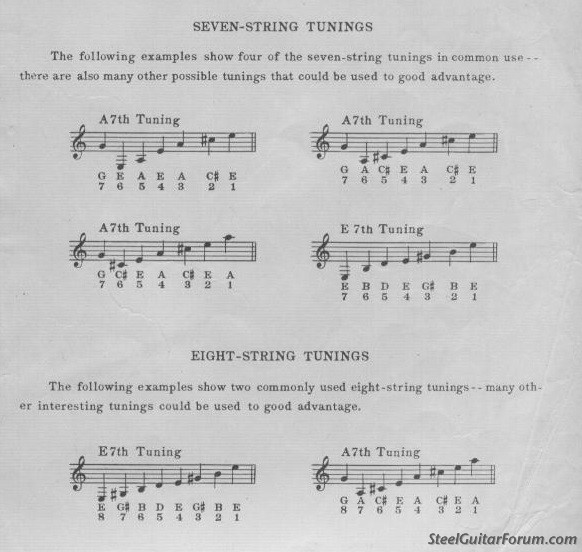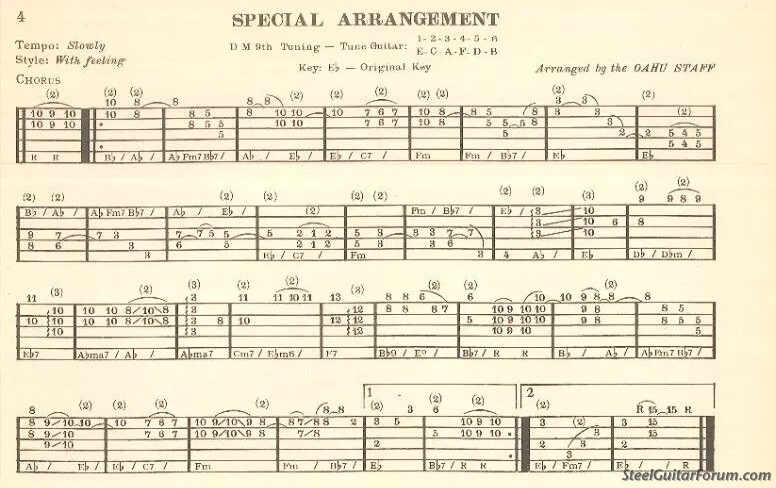| Author |
Topic: C# minor Tuning |
BJ Burbach
From:
New York, USA
|
 Posted 22 Dec 2023 6:58 am
Posted 22 Dec 2023 6:58 am |
|
Thanks for this thread, guys.
There are just so very many great people and super musicians on this forum.
Many thanks for all of the gracious help,
BJ
Last edited by BJ Burbach on 2 Jun 2024 5:30 pm; edited 2 times in total |
|
|
 |
Allan Revich
From:
Victoria, BC
|
 Posted 30 Dec 2023 10:47 am Zombie Thread
Posted 30 Dec 2023 10:47 am Zombie Thread |
|
| Post deleted. 2007 thread. |
|
|
 |
Aaron Brownwood
From:
California, USA
|
 Posted 2 Jun 2024 3:11 pm Great Thread
Posted 2 Jun 2024 3:11 pm Great Thread |
|
The forum never fails when I need info on anything steel related. I just started getting into tunings and bought Jerry Byrds book, it goes over them all and I think I've made sense of how the tunings got their names. A few years back in this thread there were questions why you'd call a tuning by its Major vs. Relative minor. Here's my take:
1. A MAJOR. It started with A low bass, low to hi (EAEAC#E), or 515135. The problem was, you couldn't get both inversions, specifically with the Root on top. A high A was not possible (still isn't) because it's too high, so they dropped the key to E.
2. E MAJOR went low to hi, EBEG#BE or 151351. Now you had both inversions of a major chord. Variations here would drop the low E and add a b7 or D note, making it a E7 tuning. However, you didn't have a minor chord at the bar, which was the next "thing" players wanted.
3. C# MINOR comes out in 1937-1938 according to Byrd, but it's just an E tuning with a C# note instead of a B. Because minor chords were so desired and not available before, players called this tuning C# MINOR. To call this E6 tuning would have made more logical sense but by calling it C#m, you were sure this tuning would give you the 6 minor chord. This tuning gave you the minor chord but you lost one of the major chord inversions.
4. C6 tuning comes out in 1939 according to Byrd, which gave you a major chord in root position and both inversions AND it gave you a relative minor, all on 6 strings. It could have been called A Minor tuning, but now this was a departure from everyone wanting a minor chord, to wanting it all. All three inversions and a minor chord did not exist yet until C6.
The bonus about C6 is you can tune it to E13, C#m, and all those other tunings because it sits in the middle of A and E. |
|
|
 |
Joe A. Roberts
From:
Seoul, South Korea
|
 Posted 2 Jun 2024 5:49 pm Re: Great Thread
Posted 2 Jun 2024 5:49 pm Re: Great Thread |
|
Aaron, I appreciate your thoughtful post.
| Aaron Brownwood wrote: |
1. A MAJOR. It started with A low bass, low to hi (EAEAC#E), or 515135. The problem was, you couldn't get both inversions, specifically with the Root on top. A high A was not possible (still isn't) because it's too high, so they dropped the key to E. |
I don't know if many people would want to do it, but high A was and still is possible, especially on short scale.
There are a couple of late 1930s sources listing expanded A tunings with high A strings.
From Alvino Rey Method, I believe 1937:

Consider that a pedal steel, at 24" scale length regularly pulls up to A from G#.
Also tenor banjo had a standard scale length of I believe 23 inches with A as the high string.
That first banjo string is probably what steel players were using for the high G# on E tunings and the high A on A tunings.
The National catalog from around then even had a string for high B! Now the possibility of that I am less sure of, never tried.
Maybe with one of those Billy Gibbons .007 gauge top strings...
---
Here is a rare tab of Make Believe Island, by Wilhelm Grosz, composer of Harbor Lights and Red Sails in the Sunset:

That tab is dated 1940, using what they call "D M 9th", others call it "G11th" or "G13th".
E
C
A
F
D
B
As far as I know, it is the earliest attested tuning with 6 different pitches, so there is another chronological milestone to add to the list  |
|
|
 |
Joe A. Roberts
From:
Seoul, South Korea
|
 Posted 4 Jun 2024 6:44 am
Posted 4 Jun 2024 6:44 am |
|
To follow up with more interesting historical high A string use, Don Helms second neck, B11th, was known to be spelled:
E
C#
A
F#
D#
B
A
F#
However, Mr. Gene Warner said that (on an unspecified date) Don wrote this tuning down for him in the margins of his Hank Williams EP:
A
E
C#
A
F#
D#
B
A(bass)
So it seems he was experimenting with a high A at that time, which makes sense since he was known for that high lonesome sound.
With that arrangement the top 4 strings are the same as open D a fifth higher!
If the E string is tuned up to F#, you would have the top 5 of the C#min tuning in the original post, to get back on topic  |
|
|
 |
Allan Revich
From:
Victoria, BC
|
 Posted 4 Jun 2024 11:17 am
Posted 4 Jun 2024 11:17 am |
|
| Joe A. Roberts wrote: |
…
A
E
C#
A
F#
D#
B
A(bass)
…
|
A lot of great root position chords lay out nicely in that tuning. You’d need nice, smooth hardware, and a soft touch to keep from breaking that high A, I think. The same tuning without the high A would also be nice on 7 strings.
_________________
Current Tunings:
6 String | G – G B D G B D
7 String | G6 – e G B D G B D (re-entrant)
https://papadafoe.com/lap-steel-tuning-database |
|
|
 |




